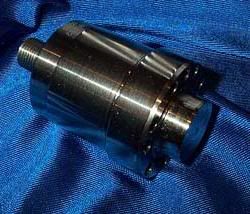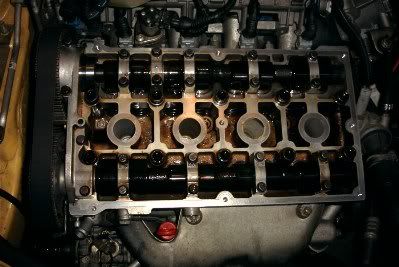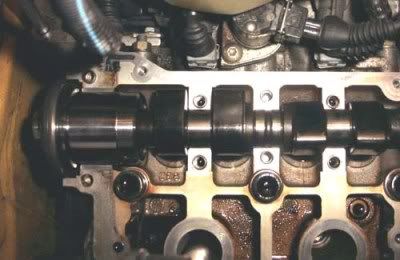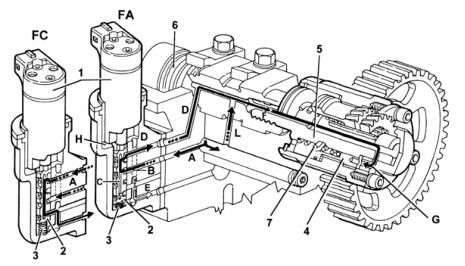This is a copy of a post by Craig_HGT so a big thanks to him.
Phase Variator,

The Function of the vvt unit or phase variator is to
1. Reduce emissions
2. Produce a better torque output under various operating conditions.
(i need to verify these also, i think there might be another point to add)
The variator is fitted in between the inlet camshaft and pulley, you can just about see the base of the variator in the pic below
The pic below shows the variator better from when i removed the camshaft support and pulley, you can also see the oil supply channel which is cut into the camshaft on the second bearing journal.
Operation.
The solenoid valve controls the oil supply to the variator depending on the load conditions of the engine which is calculated by the ecu using the RPM sensor & air flow meter.


It does this by altering the inlet camshaft position (or phase) by 25 degrees relative to the crank position, it does not and cannot alter valve lift or duration, that is decided by the camshaft profile which can't possibly change as its a solid cast (as in the above pics).
The exhaust cam position, lift and duration are fixed in all circumstances as its driven directly by the exhaust cam pulley.

FA refers to the solenoid in the advance position,
FC refers to the soilenoid in the retard position.
Advance stage,
The sliding valve is pushed down as the ecu operates the relay which supplies current to the solenoid.
Oil is now pumped through supply line A to B, D and also L. The variator is now getting a pressurised oil supply, which causes the ram to overcome the force of its return spring and be pushed away from the camshaft pulley.
it is the straight cut splines on the centre of the variator (or the part which screws onto the cam) and the helical cut teeth on the inner surface of the shell of the variator which causes the variation in relationship of the inlet cam pulley and the shaft itself.
Retard stage,
The sliding valve (2) has now lifted because the solenoid has no current flow, this allows the slide valve to lift because of the force provided by its return spring (3) thereby opening port E
Pressure is reduced in lines D and L.
The strong spring in the variator is pushing the ram back home, this causes the inlet cam to revert back to its retard position because the oil flows back through the camshaft, D also L, A and B to the slide valve where it goes to E, the lubrication system return line.
The D&L lines both go to the same oil feed bearing journal, the L line looks like it can be done without, but that would cause the journal to only recieve lubrication when the variator is advanced, which is a bad thing
the VVT system on the hgt cannot be compared to that of honda's vtec, it works on a totally different principle.
Phase Variator,

The Function of the vvt unit or phase variator is to
1. Reduce emissions
2. Produce a better torque output under various operating conditions.
(i need to verify these also, i think there might be another point to add)
The variator is fitted in between the inlet camshaft and pulley, you can just about see the base of the variator in the pic below
The pic below shows the variator better from when i removed the camshaft support and pulley, you can also see the oil supply channel which is cut into the camshaft on the second bearing journal.
Operation.
The solenoid valve controls the oil supply to the variator depending on the load conditions of the engine which is calculated by the ecu using the RPM sensor & air flow meter.


It does this by altering the inlet camshaft position (or phase) by 25 degrees relative to the crank position, it does not and cannot alter valve lift or duration, that is decided by the camshaft profile which can't possibly change as its a solid cast (as in the above pics).
The exhaust cam position, lift and duration are fixed in all circumstances as its driven directly by the exhaust cam pulley.

FA refers to the solenoid in the advance position,
FC refers to the soilenoid in the retard position.
Advance stage,
The sliding valve is pushed down as the ecu operates the relay which supplies current to the solenoid.
Oil is now pumped through supply line A to B, D and also L. The variator is now getting a pressurised oil supply, which causes the ram to overcome the force of its return spring and be pushed away from the camshaft pulley.
it is the straight cut splines on the centre of the variator (or the part which screws onto the cam) and the helical cut teeth on the inner surface of the shell of the variator which causes the variation in relationship of the inlet cam pulley and the shaft itself.
Retard stage,
The sliding valve (2) has now lifted because the solenoid has no current flow, this allows the slide valve to lift because of the force provided by its return spring (3) thereby opening port E
Pressure is reduced in lines D and L.
The strong spring in the variator is pushing the ram back home, this causes the inlet cam to revert back to its retard position because the oil flows back through the camshaft, D also L, A and B to the slide valve where it goes to E, the lubrication system return line.
The D&L lines both go to the same oil feed bearing journal, the L line looks like it can be done without, but that would cause the journal to only recieve lubrication when the variator is advanced, which is a bad thing
the VVT system on the hgt cannot be compared to that of honda's vtec, it works on a totally different principle.





